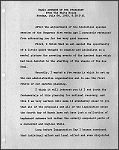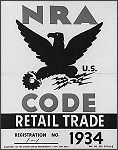
FDR's Fireside Chat on the Recovery Program
Background
When Franklin Delano Roosevelt was elected to the presidency in 1932, it was on a promise to restore the confidence of the American people and to bring America out of the Great Depression. Roosevelt stated in his first inaugural address that "we have nothing to fear but fear itself." His objectives were to calm the economic fears of Americans, develop policies to alleviate the problems of the Great Depression, and gain the support of the American people for his programs.
Immediately after his election, Roosevelt began to formulate policies to bring about relief from the economic hardships the American people were experiencing. These programs became known as the New Deal, a reference taken from a campaign speech in which he promised a "new deal for the American people." The New Deal focused on three general goals: relief for the needy, economic recovery, and financial reform. During the One Hundred Days, Congress enacted 15 major pieces of legislation establishing New Deal agencies and programs. Among these was the Federal Deposit Insurance Corporation (FDIC), which was established to protect depositors from losing their savings in the event of bank failure. Another program was the Civilian Conservation Corps (CCC), which put thousands of men to work on projects in national forests, parks, and public lands. The Agricultural Adjustment Administration (AAA) was created to ease the desperate plight of the farmer during the Depression by establishing a program of production limits and federal subsidies. To address the problems of industry and workers, Congress passed the National Industrial Recovery Act (NIRA) in June 1933. The NIRA established codes of fair practice for individual industries in order to promote industrial growth. It also created the National Recovery Administration (NRA). The NRA was perhaps one of the most sweeping and controversial of the early New Deal programs. Its purposes were twofold: first, to stabilize business with codes of "fair" competitive practice and, second, to generate more purchasing power by providing jobs, defining labor standards, and raising wages. The NRA also reflected trade union hopes for protection of basic hour and wage standards and liberal hopes for comprehensive planning. General Hugh S. Johnson headed the NRA and eventually proposed a "blanket code" pledging employers generally to observe the same labor standards. By mid-July 1933 he launched a crusade to whip up popular support for the NRA and its symbol of compliance, the "Blue Eagle," with the motto "We do our part." The eagle, which had been modeled on an Indian thunderbird, was displayed in windows and stamped on products to show a business's compliance. There was even a parade down New York's Fifth Avenue with over a quarter of a million marchers in September to show support for the NRA and the "Blue Eagle."
While developing programs to help America emerge from the Great Depression, Roosevelt also needed to calm the fears and restore the confidence of Americans and to gain their support for the programs of the New Deal, including the NRA. One of the ways FDR chose to accomplish this was through the radio, the most direct means of access to the American people. During the 1930s almost every home had a radio, and families typically spent several hours a day gathered together, listening to their favorite programs. Roosevelt called his radio talks about issues of public concern "Fireside Chats." Informal and relaxed, the talks made Americans feel as if President Roosevelt was talking directly to them. Roosevelt continued to use fireside chats throughout his presidency to address the fears and concerns of the American people as well as to inform them of the positions and actions taken by the U.S. government.
The topic of this lesson's featured document, Fireside Chat on the Purposes and Foundations of the Recovery Program, was the NRA. Although this radio message, given on July 24, 1933, addressed some of the problems and issues of the Great Depression, it also focused on what industry, employers, and workers could do to bring about economic recovery.
For a time, the NRA worked. It gave an air of confidence to the American people to overcome the fears of the Depression and the downward turn of wages and prices. However, once recovery began, hostility among businessmen grew with the daily annoyances of code enforcement. Within two years the NRA had developed many critics and by May 1935 was struck down by the Supreme Court as unconstitutional. The experiment of the NRA was generally put down as a failure. Nevertheless, the codes had set new standards for business and workers such as the 40-hour week and the end of child labor. The NRA also helped the growth of unions with the endorsement of collective bargaining.
Resources
Allen, Frederick Lewis. Only Yesterday and Since Yesterday: A Popular History of the '20s and '30s. New York: Bonanza Books, 1986.
Foner, Eric, and John A. Garraty, eds. The Reader's Companion to American History. Boston: Houghton Mifflin, 1991.
Tindall, George Brown, with David E. Shi. America: A Narrative History. New York: W.W. Norton and Company, 1992.
The Documents
Fireside Chat on the Purposes and Foundations of the Recovery Program
July 24, 1933

View on DocsTeach, the online tool for teaching with documents from the National Archives
Franklin D. Roosevelt Library
First Carbon Files
1933 - 1945
National Archives Identifier: 197304
Poster Displayed by Business to Show Participation and Support for the NRA Program
ca. 1934

Click to Enlarge
Franklin D. Roosevelt Library
Public Domain Photographs
1882-1962
National Archives Identifier: 195507
Photograph of a Woman Hanging an NRA Poster in the Window of a Restaurant
ca. 1934

Click to Enlarge
Franklin D. Roosevelt Library
Public Domain Photographs
1882-1962
National Archives Identifier: 196519